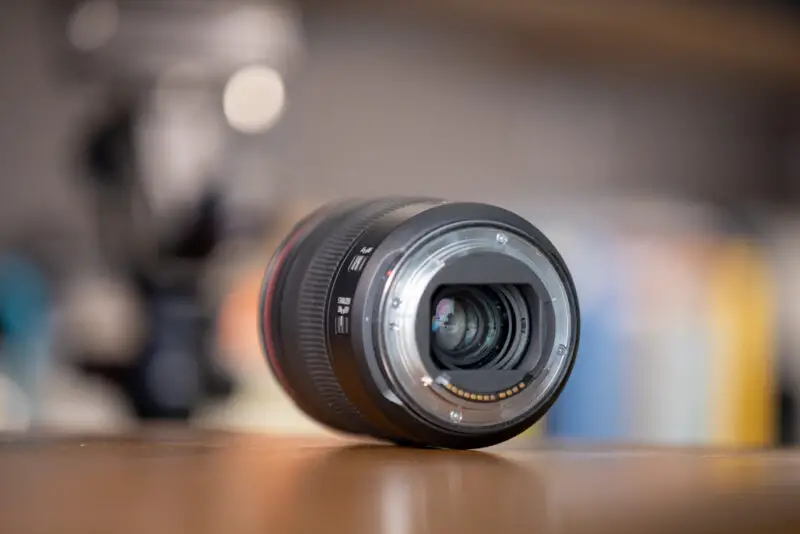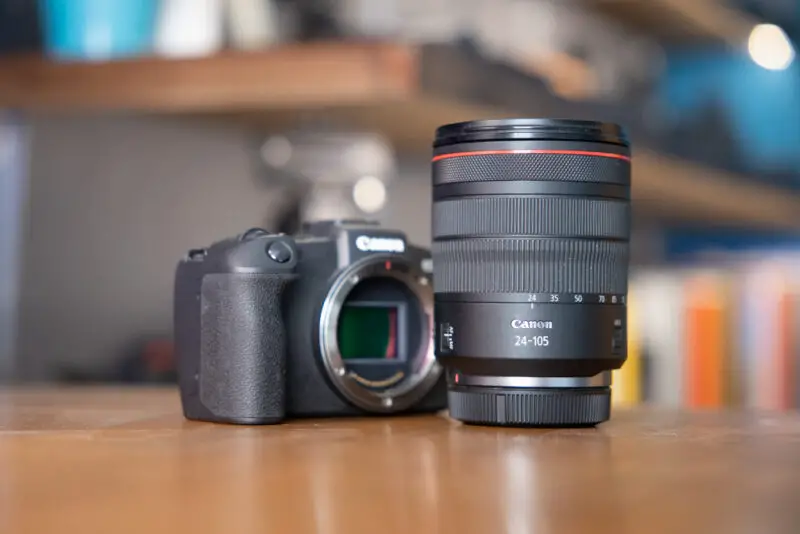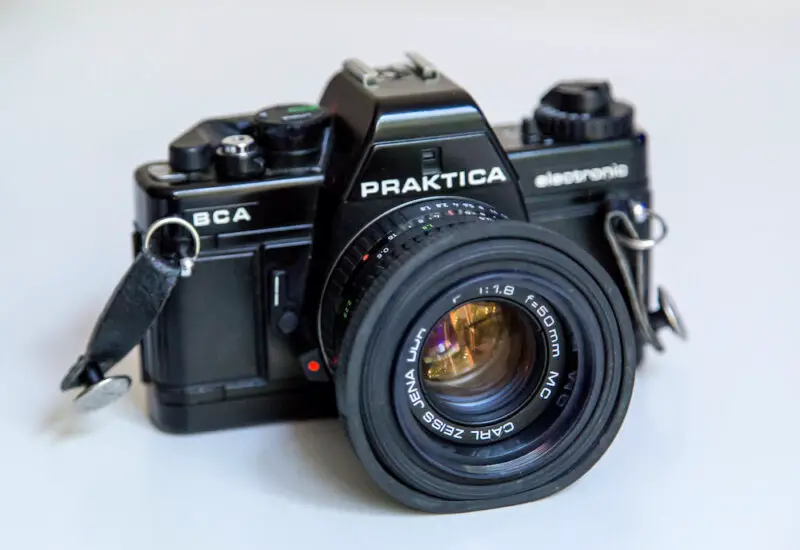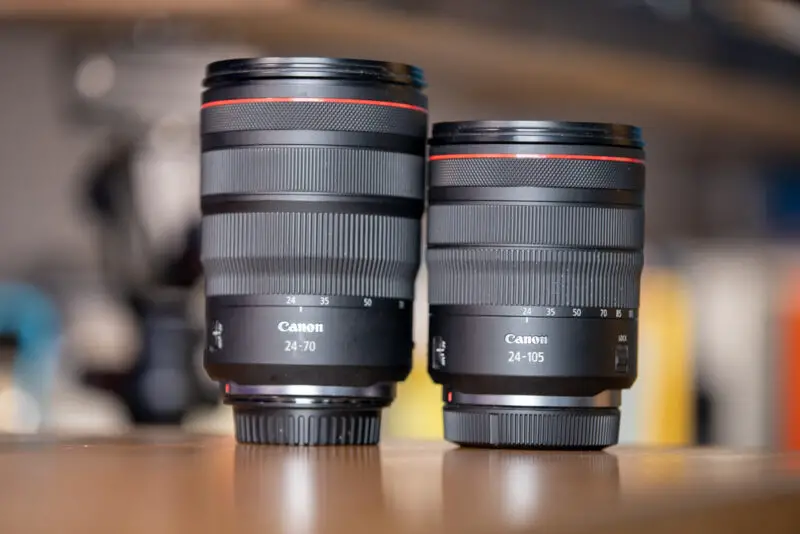The Canon RF 24 105 f/4L IS USM was released as the first flagship lens for the RF mount not so long ago in 2018. Suffice it to say that this is a complicated lens with a list of specifications and features almost as long as its somewhat unwieldy name.
And at a list price of just short of $1,000, it’s not exactly a purchase most of us will be considering lightly.
That is why I went ahead and put this lens under the microscope for you, dear Canonite reader. Let’s take a good long look at the Canon RF 24 105 (I will allow myself to use this nickname from now on) and find out who it’s for and where its strengths and weaknesses lie!
Technical Overview Of The Canon RF 24 105
First, let’s talk about the meaty stuff. Specs may not be everything, but they sure matter to a lot of photographers out there. Besides, they can tell us a lot about how this lens might perform in the field.
Lens Designation
Especially these days, lens names have gotten so long and complex that it’s sometimes tricky to keep track of what means what.
That’s a shame, as the official lens designations of makers like Canon are neat (if somewhat inefficient) ways of communicating some of the most important aspects of the design.
Let’s go over everything one by one.
The RF Mount
This is a Canon RF lens, meaning that it uses the Canon RF mount, compatible with their full-frame MILCs. This includes any of Canon’s line of EOS R camera bodies.
Two curious exceptions to this are the R7 and R10, which, while compatible with RF lenses, are not full-frame cameras. They use crop sensors instead, giving you a smaller image circle filling out the center of what the lens sees.
Note that, because of the much shorter flange distance inherent in mirrorless cameras, you cannot adapt RF lenses to use on Canon DSLRs native to the EF or EF-S mount.
You can, however, convert EF and EF-S lenses to work on RF bodies quite easily.
Focal Length Range And Maximum Aperture
Moving on, this is a 24-105mm f/4 lens. Meaning, that the maximum aperture stays constant throughout the zoom range. So far, so good! Constant-aperture zooms have been the hallmark of “pro” camera bags since the 80s, and for good reason.
As long as the aperture is fast enough for your needs, carrying around such a zoom gets you that much closer to replacing a whole collection of primes with one lens of (more or less) equal quality.
L For Luxury
There is an L after the f-number to denote that this is one of Canon’s “luxury” line of pro-grade lenses.
You might also notice the red ring around the barrel; that’s the second visual indicator to confirm that fact, similar to Nikon’s use of gold rings. The ring itself doesn’t do anything, of course. It’s just cosmetic.
But under the hood, rest assured that Canon employed some manufacturing techniques and tight tolerances not found in many of their lesser-grade consumer products.
Image Stabilization
Next, is the IS marker. This specifies that this lens features built-in Image Stabilization. If you’re paying us a visit from Camp Nikon, that’s Vibration Reduction to you. It’s the same thing.
Image Stabilization is particularly useful for lenses with a longer reach since camera shake becomes more apparent at greater focal lengths. Since this Canon zooms out to 105mm, IS is a really neat feature to have.
What’s even better is that the IS used in this lens can compensate for over five stops of shake. That’s a truly huge range that should cover nearly any shooting scenario.
Focusing Motor Mechanism
Finally, the last acronym that rounds out this lens’ name is USM, which stands for Ultra Sonic Motor. If the name alone reminds you of the Nikon-patented Sonic Wave Motor (SWM), you’re on the right track – it’s a very similar technology.
The Ultra Sonic Motor is Canon’s mainstay autofocus system, incorporated neatly into the assembly of the lens barrel. Versions of the USM have been in use since the 90s, though of course the Canon 24-105mm makes do with a slightly updated variant, called the Nano USM.
This is further assisted by a separate STM, a so-called Stepper Motor. Yeah, it’s not a perfect acronym, but at least Canon left it out of the name of the lens in exchange! The STM particularly helps with shooting video because it is capable of changing fine focus even quicker and more quietly.
The principle behind using not just one, but two dedicated lens-based focusing motors like this is twofold.
First, they can be optimized for the particular focusing throw of the individual lens. This makes focusing snappier and quicker. And second, by using ultrasound technology to drive the AF system, they can be quieter, too.
It does make for a heavier, bulkier lens, but those are the kinds of tradeoffs you make for top-flight performance.
And there you have it. Putting it all together, that’s the Canon RF 24-105mm f/4L IS USM for you.
Rolls right off your tongue now, doesn’t it?
Optical Design
Now, let’s take a look at the inner workings of this hulk of glass to get an idea of the optical quality we’re working with.
The Canon RF 24 105 is quite a hefty lens, weighing in at 700 grams, or 25 ounces.
Taking a look inside reveals the reason why: apart from the Ultra Sonic Motor and the Stepping Motor, there are a whopping 18 elements in 14 groups in there! Let me spell that out again: eighteen elements in fourteen groups!
That’s more glass than I usually take with me on an average photo walk…and that’s with two, sometimes three or four lenses and two camera bodies!
Of course, Canon wasn’t messing around when they designed this lens that way. The idea is to maximize visual quality while minimizing artifacts, particularly important with a lens with such a wide, useful zoom range.
My trusty Nikon 25-50mm f/4 AI-s from the early 80s (a comparison that will keep popping up in this guide, I feel) is likewise a pro-grade normal zoom with a surprisingly generous wide end, sharing the same max aperture as the Canon.
But crucially, its much more narrow range means it can get by with only 11 elements in 10 groups.
That’s still quite a lot, but we’re also talking about one of the most famously distortion-free wide-to-normal zooms ever made! Can the Canon’s added complexity, high-tech whistles, and mirrorless design allow it to measure up? Or is it all fluff?
Let’s see!
Additional Specs
As mentioned previously, this is a pretty hefty, large, and heavy lens. This is of course perfectly fair and excusable for the kind of lens that we’re talking about – essentially a jack-of-all-trades superzoom.
What’s actually curious to me is that Canon chose to not include a tripod collar in such a bulky design. Particularly when zoomed out all the way, the barrel extends so far that it makes the whole thing extremely front-heavy. For what it’s worth, there’s still more than enough space to add one of those cheap aftermarket collars if you wish.
The titanic dimensions don’t stop at the front as they do with some zooms, courtesy of the wide low end. This means you have to deal with a ridiculously imposing front element that demands a 77mm filter ring.
At least this can make for some particularly sexy gear photography if that’s your thing.
The rest of the specifications of the Canon 24-105 look quite promising. Angles of view range from 23 all the way to 84 degrees, and the minimum focusing distance is a solid 45 centimeters, very close indeed.
The minimum aperture is a perfectly serviceable f/22. Nothing to write home about, especially at 105mm, but there’s worse.
The aperture blades are rounded at the edges and number 9 in total. This makes for dreamy-looking, soft out-of-focus backgrounds. Sunstars are also very neatly defined and pleasing to the eye.
Canon RF 24 105 Performance In The Field
Now is the time for the Canon 24-105 to really stand trial. How does it fare in real-life shooting?
Well, after taking it out for a spin, let me start off by saying the answer is fairly unanimous.
This is not one of those “maybe for some, not for everyone” kinds of lenses. I imagine it will be fairly easy for most photogs to decide whether this lens is worth the expense or not.
Let’s go over the way this lens executes its mission in practical testing, bit by bit.
Ergonomics
Some might not find this such a crucial aspect of lens performance, but I tend to place a pretty high value on the way a lens feels in the hands. Especially something like the Canon 24-105mm f/4, with its weight and size, needs to be balanced and textured appropriately to be nice to handle.
Otherwise, even with stellar optical performance, using it might be a chore.
Well, I am happy to report that the basic ergonomics of this lens offers next to no surprises, very much in a good way.
Controls
The control layout of this lens follows what might as well be an established standard for mirrorless pro lenses.
Closest to the lens mount of the Canon RF 24-105, you have switches for AF/MF, the Image Stabilization, and a lock for the zoom.
The grippy, wide ring closest to you is the zoom ring. It’s labeled exactly as you’d expect, and the throw is surprisingly short for such a big zoom range. However, there is quite a bit of damping, so it’s pretty hard to slip.
Up from there, there’s a slightly narrower ring. This is your manual focus ring.
Closest to the front element is the narrowest, yet grippiest ring, finely textured with a knurled pattern that is very pleasant to hold or pinch with two fingers.
This is the wild card of the Canon RF 24-105: a programmable ring that you can set up to do just about whatever you want. ISO, exposure compensation, aperture…white balance? You name it, it’s got it.
The Problem With Focus-by-Wire
And here’s where things get confusing – at least for someone like me, raised on the machinery of yore.
While the zoom ring is perfectly old-fashioned and works via a mechanical linkage, the other rings aren’t and don’t.
They’re electronic, or focus-by-wire if you prefer.
On the one hand, this allows for some pretty nifty party tricks – like the programmability feature I just mentioned. On the other hand, this means that these rings are both completely unlabeled. That is to say, blank. Empty. Devoid of information.
You get the idea.
On my Nikon 25-50 f/4 (told you it was going to re-appear), I have one labeled scale each for focus, zoom, and aperture. Simple as that. Want to set up your shot without using the viewfinder? Just take a look at the lens.
With the Canon, you get absolutely no visual feedback on anything except focal length.
For me, that was very tricky to get used to at first.
I learned photography on a manual 35mm rangefinder, where knowing and using the lens scales is absolutely essential – and I still work that way today. Others may differ, but this is where I’m coming from.
Of course, Canon didn’t just decide to remove essential features from this flagship product for no reason. They simply relocated them to fit the new design language of the EOS R series.
You can still get depth-of-field confirmation, a proper focus scale, aperture readout, and even more when using the Canon 24-105mm f/4 – the only catch? You have to be looking through the EVF to do so.
Is that worth it? Your call. Ultimately, you’re not losing out on functionality here at all. It’s simply another way of thinking about how you use your lens ergonomically.
Handling, Build, And Flexibility
We’ve covered the ergonomics of the Canon’s controls, but how does it stack up being thrown around a bit?
No, not out of a window or under a moving truck. This is not one of those apocalyptic prepper-style reviews, don’t worry.
What I mean is: after a solid day of using this lens out and about, at every focal length and with a variety of subjects, do you feel like you’d rather have taken something else with you or not?
For me, the answer was a pretty solid no. I’ll admit, I still need more time to get used to the controls.
But much of that can be levied against all of Canon’s EOS R cameras and lenses.
Apart from these minor quibbles, the Canon 24-105mm performed admirably.
Despite the all-plastic exterior, the lens feels tough and sturdy, with no rattles or play where there shouldn’t be. Though having those override switches near the base of the lens is nice, I never needed to use them.
The one drawback of such a versatile zoom that does, unfortunately, get in the way sometimes is how much the barrel extends. At 105mm, the lens grows to practically twice its “resting” size.
If you shoot close to the telephoto range more often than not, this could be important to you. It does make the lens a lot more cumbersome, especially handheld.
Canon RF 24 105 Image Quality
Ah, here we finally are. The reason why I deliberately took my time to arrive at this supremely important (and supremely subjective) part of this review is just that: supreme importance and supreme subjectivity.
When discussing a lens – any lens – the very first thing everyone wants to hear is whether it takes good pictures. Different people will use different words. Some might say “sharp”, others “lifelike”, yet others “contrasty” or “vibrant”.
But in the end, these words aren’t taken out of the dictionary when we use them in this way as photographers and as viewers of photography. They are stand-ins for the meaning of, “aesthetic quality that I like or prefer”.
This is why I took my time with the technical specs, the appearance and functions of the lens, and some words on how it feels as well – to give you an idea of what it is like to use before I delve into the most unsubstantiated assessment of them all.
So, in the end, what is the Canon RF 24-105 like in terms of picture quality?
By any more or less “objective” standard, it’s brilliant. Sharpness is excellent for a zoom. You’d be hard-pressed to spot corner falloff with the naked eye.
Distortion is kept at a minimum by way of the optical design, but EOS R cameras can correct what little distortion there is automatically anyway.
I couldn’t spot major optical flaws such as coma or diffraction issues. However, because of the huge front element, using this lens without a hood can attract some ghosts or softness in bright lighting.
Focus, whether manual or automatic, does what you tell it to do within the blink of an eye. It just goes.
All in all, this lens does what photography textbooks tell us lenses should do.
And it does it across a wide range of focal lengths, with little in the way of optical compromise.
Why A Normal Zoom, Anyway?
The Canon RF 24-105mm is a lens with a very impressive, broad range of focal lengths and a constant maximum aperture.
You’d think this is a great thing – but then why isn’t every lens made this way?
The answer, as it so often does, lies in history.
The Appeal of Primes
If you were a photographer at almost any time during the last century shooting in full-frame equivalent (that is, on Kodak 135 film), and you wanted a lens that is more or less good enough for the vast majority of shooting situations, there was really only one to go for. The nifty fifty.
Even from the most prized brands, 50mm primes were cheap to buy, easy to use, and light for travel. Their relatively basic optical designs (usually three to six elements only) also made them affordable, even to newbies.
At the same time, their optical quality was outright fantastic, still rivaling some of the best we’ve got today.
Not to mention that they can be had with silly maximum apertures for even sillier prices. In the 70s, any average SLR even from a third-rate brand would likely ship with a 50mm f/1.8 or f/1.4 kit lens – anything smaller than f/2 was considered slow back then!
If you really wanted to show off and could afford the higher price, an f/1.2 fast fifty was the holy grail, with even more insane primes available to this day specifically for night photography.
Of course, it’s important to note that super fast lenses like these have their own optical quirks that aren’t necessarily the best for every kind of photography.
The Arrival Of Zooms
Starting in the 1980s, zooms became increasingly more of a big deal.
Of course, they had been around before then. Largely experimental zooms had been made for rangefinders in the 1950s, and between the 60s and 70s Nikon, to name only one, explored their potential for SLRs.
But, despite their obvious advantage of versatility compared to primes, it did take many years for them to catch on. What’s that about?
Well, early zooms in particular had a big reputation for poor image quality and lots of artifacts. This was not an unearned reputation – zooms back then were real optical compromises compared to much cheaper primes.
An infamous example is the Nikon 43-86mm f/3.5 lens, first released as early as 1963. That lens became so well-known for its aberrations, vignetting, lack of sharpness, and overall “mushy” look that it hurt the reputation of zooms for many years to come.
Because of that, many continued to see zooms as “convenience lenses”, mostly for very specialized pro photographers that needed to switch between different perspectives very quickly and didn’t put a high emphasis on sharpness, detail, or color rendition.
Improvements In Zoom Design
Over time, technology evolved. And with that, zooms gradually became more and more common across the spectrum.
By the mid-1990s, the average Joe wouldn’t identify you as a “professional photographer” if you weren’t packing a gigantic autofocus zoom lens.
By the 2000s, almost all digital and film cameras came kitted with wide-range zoom lenses instead of 50mm primes.
And that leads us to today. The market share of zooms versus primes has stabilized. Most people buy zooms for everything, but there remains and likely always will be a solid following of prime users as well.
The quality gap between the two has narrowed a lot, to the point where lenses like the Canon RF 24-105mm can offer performance that is, to the naked or layman’s eye, indistinguishable from that of a good prime.
At the same time, it covers a range that in the old days would be filled with up to six different prime lenses!
That is why today, the difference between the two is a lot more about nuances such as ergonomics, weight, size, and build rather than outright optical performance.
The one area where zooms will probably never be able to quite catch up, though, is in terms of speed.
That’s a matter of optical physics. So, if you need fast apertures for your work, primes are going to remain indispensable.
The Bottom Line
Now that we have examined the Canon RF 24-105mm from as much of an objective angle as I could muster, let me make my own, totally personal verdict.
Is this lens technically, mechanically, and in most other ways absolutely capable of great pictures?
Of course, it is. But the idea that only special kinds of lenses have that power is an elitist mode of thought that puts pro equipment on a pedestal just a few light-years too high.
It’s a snowclone at this point, but remember that Ansel Adams shot some of his best work on various point-and-shoots, including a Polaroid.
This is a unique situation we face now, towards the end of the beginning of the 21st century.
Technology has gotten so bafflingly good that, if you’re buying brand-new equipment, you can almost not go wrong.
Here’s the thing though. If I could get this lens for free, would I use it day-to-day in my photography?
Honestly, I’m not so sure.
This doesn’t have to do so much with concerns about how my photos will turn out as much as it does with how easy this lens makes it to take the kinds of photos I prefer. Yes, this includes the aforementioned ergonomic gripes, but it goes deeper than that.
It would be too exhaustive to go over every single relevant factor, so let me give you one example.
The Case For The Photographer, Not The Lens
In my work, I mostly shoot between 25mm and 50mm of focal length. For longer reach, I like to pack a small, compact telephoto prime. Often, I leave that out entirely when I know I won’t be needing it.
This makes the added bulk and “versatility” of something like the 24-105mm counterproductive to me.
In that sense, I encourage those reading this review, especially beginners, to ask themselves if this kind of lens is what they really need.
I’m not trying to make an appeal to rationality here among followers of an incredibly irrational art form and hobby. But what I am trying to do is make the case that what you don’t actively use in your work weighs you down.
In the case of the 700-gram Canon RF 24-105mm, that’s also, but not only, literal.
One Final Word On The Canon RF 24 105
Especially with the rise of photography bloggers and reviewers like yours truly, we have gotten accustomed to this almost ritual chase for the “best” this or the “best” that.
Whether it’s some obscure third-party lens that has “the most amazing bokeh” or a long-forgotten camera system from the 60s that was actually superior to the Nikon F all along, this community of ours loves two things: superlatives and competition.
That’s fine if you like learning about the history, science, and engineering aspects of photography while also taking in some solid shopping advice and sensationalist, opinionated content.
But is that really the reason why you clicked on this review? For some of you, it might be. But many others are probably just wanting to find out if they can take pretty photos with what they’ve got.
And considering that the Canon RF 24-105mm f/4 mostly ships as a kit lens for EOS R cameras, meaning that most of you will already be in possession of one reading while reading this review, I only have one answer.
Yes. This lens is enough. In fact, it alone is more than enough to take pictures that could change the world, topple governments, win Pulitzer and Nobel prizes, and much more.
The only reason to not get this lens, or to get a specific alternative, is if you don’t like how it looks, feels, or handles, or if it for some other reason doesn’t align with your workflow or your artistic goals. That’s it.
Enjoy shooting!







